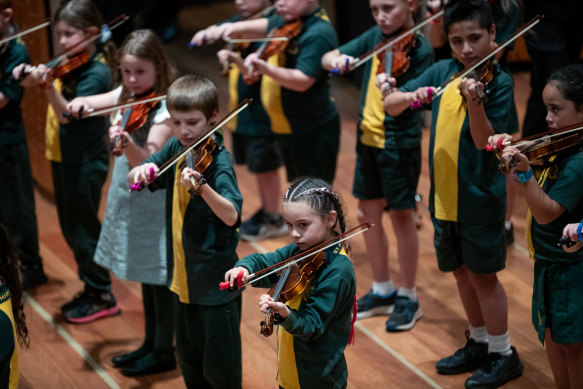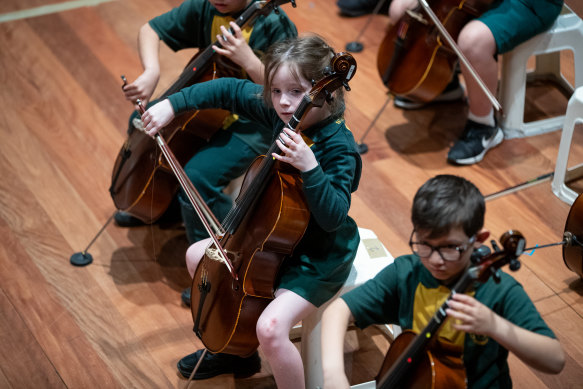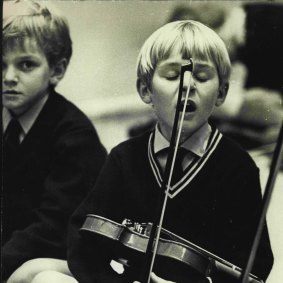By Helen Pitt
When six-year-old Rebel Nordsven began learning to play the cello earlier this year, she was barely big enough to hold the instrument upright.
“It was a bit hard,” the year 1 student at St Marys North Public said. “I always forgot how to hold the cello properly down below.”

ACO artistic director Richard Tognetti with pupils from St Marys North Public School: (from left) Tanginoa Halaifonua-Palu, 6, Ava Tuckwood, 6, and Rebel Nordsven, 6, tune up before they play on Friday.Credit: Edwina Pickles
While the tiny string musician known to her family as “Rebel the devil” may not have grown much in height this past year, she has in musical knowledge thanks to music classes at the start of each school day through a pilot program run by the Australian Chamber Orchestra Foundations Program in one of the most disadvantaged areas of Sydney.
It may be 41 kilometres between her school and the ACO’s Walsh Bay HQ, but the two places couldn’t be further apart: the school in western Sydney has one of the lowest rates of SES – supplemental education services – in the state, while the ACO has a roll-call of some of the richest donors in the nation.
Since 2018, though, all students from years 1 to 3 have begun each school day with 15 minutes of music practice guided by their classroom teacher, with the violins and cellos provided by the ACO.

University of Sydney academics have followed a pilot program at St Marys North Public School to evaluate the benefits of learning a musical instrument.Credit: Edwina Pickles
They also receive weekly lessons with an ACO music teacher and are offered regular workshops with ACO musicians so that music is completely integrated within the school curriculum.
On Friday, Nordsven and 176 children from her primary school, some of whom had never seen the Sydney Harbour Bridge before, got to play in its shadow over at the ACO’s Neilson room before their families, NSW Governor Margaret Beazley and representatives of the NSW Education Department.
The performance was the culmination of five years’ work between the school and the ACO that has been followed closely by researchers and academics at the University of Sydney, who have tracked the impact it’s had on the school and its pupils.
Their evaluation report has noted improvements in the pupils’ cognitive and academic abilities (including verbal and written communication skills and mathematical reasoning), emotional, physical and behavioural development and motivation at school.
How music education can bring permanent changes to students:
Students start playing a musical instrument before the age of seven.
Practise takes place regularly – at least 15 minutes a day (not weekly, or monthly classes).
Students to continue for at least two years, but preferably three.
Teaching to be engaging and entertaining.
Students need to love it.
Music needs to be embedded like learning the alphabet.
University of Sydney findings in an evaluation report of a pilot program run between the Australian Chamber Orchestra and St Marys North Public School.
St Marys North principal Lisa Parello, who had taught at the school for 31 years before she became principal six years ago, said it was less about improved NAPLAN scores for her pupils than about teaching them resilience to become better learners.
“This program changes lives and opens doors our students didn’t know existed,” Parello said. “I would like to see more of this – and a change in the way music education is delivered in all public schools.”
The program won an outstanding initiative award from the Education Department.
Dr Anita Collins, who was brought on as a music consultant to teach the primary teachers, none of whom had played a musical instrument before, said playing a musical instrument can make permanent beneficial changes to the structure and functioning of the brain at any age.

Pupils from St Marys North Public School perform with the Australian Chamber Orchestra for their family and friends.Credit: Edwina Pickles
“Music is really infused into the teaching practices at St Marys North ... I hear music across every single lesson, whether its from singing to help improve memory to the school bell being replaced with a classical song ... when I walk through the door it is the happiest place on Earth,” Collins said.
Tara Smith, the ACO’s director of learning and engagement, said: “One of the slightly unexpected outcomes is school attendance has gone through the roof, and being on time to school is really important because the kids are practising at nine o’clock and they do not want to miss their practice.”
The University of Sydney results prove that music needs to be embedded in the curriculum, like learning the alphabet, said ACO artistic director Richard Tognetti, who himself would never have known what a violin was if one of his teachers at Pleasant Heights Public School in Wollongong had not brought the Suzuki method into his classroom.

Richard Tognetti, aged six, at Pleasant Heights Public School, learnt violin by the Suzuki method. Here he is captured at a 1972 performance at the Conservatorium of Music.Credit: Fairfax Media
“There are two regrets people usually have when they talk about education,” he said.
“They say, ‘I wish I’d learnt a language’ – you think, bloody schools – or ‘I wish I’d learnt or continued with music’ – and again you think, bloody schools’.”
“When you go to the school it’s a really emotional experience.
“I didn’t even know some of these kids have severe behavioural issues and some were more than just on the spectrum but severely neuro-challenged ... and there they are, totally focused on the music. They are flabbergastingly good,” Tognetti said.
After Friday’s performance, where tears were shed by the ACO musicians, educators and parents, and applause from the governor and audience was deafening, the final word came from violinist Lachlan Martin, a year 6 pupil who began the pilot program as a year 1 student in 2018.
“You guys are sounding great,” he told Tognetti and the ACO musicians. “You sound just like us now.”
The Morning Edition newsletter is our guide to the day’s most important and interesting stories, analysis and insights. Sign up here.